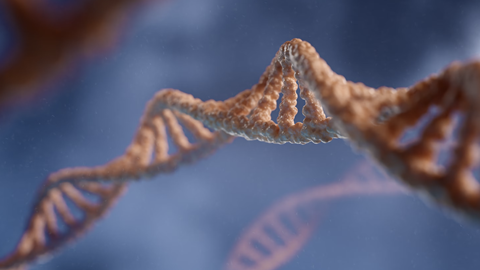The complexity and communicative qualities of our genetic building blocks are not easily explained by science, but instead point to intelligent design, argues Joel Furches
The wonder and complexity of biological life is difficult to understate. Humans are so used to the miracle of life which flourishes and fluctuates all around them, that it is easy to forget that biology is, at core, not magic, but matter. It is a combination of chemical elements like carbon, which may be found elsewhere in the universe in distinctly non-living forms.
Life, like truth and time, is very easy to recognise, but difficult to define. What makes living matter different than non-living matter? As difficult as it is to say, one feature which definitely sets life apart is its ability to self-replicate. While most multicellular organisms reproduce sexually, the very cells that exist within them are perpetually dying, reproducing, and expanding. This is a property found in no other chemical combination in the known universe, and it is made possible thanks to two tiny molecular machines engaged in an elaborate and ongoing dance: DNA and RNA.
While the geological processes within planets and the thermonuclear processes in stars are fascinating and complex, neither is so dynamic as the way in which life grows, learns, responds to its environment, evolves, and behaves. It is this very dynamism which has led people throughout history to marvel at life and conclude that there must be a mind behind it all. But is this merely a superstitious instinct passed down through the ages, or is there some reality to this belief?
Read more:
Is intelligent design a viable option?
What part of our body could stretch all the way to Pluto?
Is God fully in control?
The god of the gaps dismissal
Looking back across the ages, sceptics have noted that people always seem to ascribe to the supernatural what has proven to be quite natural. In ancient times, people left thunder and volcanoes, the rising of the sun, and the seasons themselves in the domain of the gods. These, we gradually learned, had ordinary physical explanations. Isaac Newton, for all his brilliance, did leave room for God to shepherd the planets in their unusual movements, which later proved to be quite natural when the baton was passed to the ingenious Mister Einstein.
Because of this long history of the complexity of the universe being shown to have entirely natural causes, when something like the mystery of the universe’s origin or the enigma of DNA are laid upon the table as proof for God, sceptics do what sceptics do, and remain very sceptical. The term “god of the gaps” was coined to describe the way in which humans seem to always use God as an explanation for things unknown – an explanation which proves unnecessary as science progresses.
However, it is not what we don’t know about DNA which causes us to grasp toward God, but rather what we do know. As the 21st Century creeps toward its mid-point, we have mapped the human genome in its entirety, are quite aware of its exact structure and function, and the sequences in other life forms across the planet are not far behind. In other words, there are fewer “gaps” into which a God may be shoved.
I argue that it is this very comprehensive knowledge of the inner workings of the genetic world which make God seem like a possibility – even a probability. But how so?
DNA encoding
No matter how insignificant a life form is, it contains some kind of DNA or RNA. DNA consists of two long molecules winding around one another, and joining together by nitrogenous “base pairs” like rungs along a ladder.
There are four different nucleotides which may be combined to make base pairs. It is through these four nucleotides that all of the information within a DNA strand is encoded. The English alphabet has 26 letters which may be combined in any particular order to make any of over 170,000 words. Those words form sentences, which form paragraphs, which form books, which communicate the sum total of human knowledge. Genetic code contains only four letters. The four letters contained in the DNA code - A, C, T, and G – can be combined in any order to make up the over 5 billion species living on this planet – each individual of which has a unique set of DNA. The DNA contains the blueprint for the form of the entire organism it helps to produce.
The formation of DNA
Life, from the most complex creature to the simplest bacterium, cannot exist without DNA. While evolution may do a sufficient job of explaining the diversity and complexity one sees in DNA in the modern era, it cannot explain how two chains of sugar molecules connected by pairs of nucleotides using nitrogen bonding was able to form in the first place. The simplest form of DNA is within the carsonella ruddi – a type of bacteria – and contains over 160,000 base pairs. DNA cannot self-replicate without the assistance of messenger RNA and a number of different enzymes which help the process along. What this means is that DNA, RNA, and the various enzymes which help it to unzip and re-form would all have to have formed independently and somehow begin to work together in order to replicate. Much like the question of the chicken and the egg, cells cannot form without DNA, but DNA cannot form without cells. Even viruses - which can’t properly be categorised as lifeforms - cannot reproduce without injecting their DNA into a living cell.
There are no theories yet which can adequately explain how such a complicated molecular machine could have formed by unaided natural processes – and it has stumped scientists to the extent that some have asserted quite unironically that the life on earth may have been “seeded” from another planet.
It is important at this point to make something of a distinction as regards the “god of the gaps” objection.
The concept of “god of the gaps” is that “since we don’t know how something functions, we say a god must make it work.” That objection does not work in this case, as we know exactly how DNA functions. This is more akin to finding a fully functional Toyota Sedan sitting about in the wilderness. One may study it and find out exactly how it works. It does not require a little man sitting in the engine compartment operating the pistons. It operates on its own. However, its complexity and the formation of the individual parts of the vehicle which work together to make it function, and cannot function independent of one another suggest that the entire thing was constructed by someone with a purpose and function in mind. And this is the key word: “mind.”
Information and the mind
As previously stated, DNA is a form of code which communicates information. The way in which DNA communicates this information is effective in forming the body it describes – something like the blueprints for a building actively creating the building, but much more like a string of computer code creating novel programs, or like the letters of the alphabet coming together to form original novels.
When the Human Genome Project mapped out the details of human genetics, what it discovered was language – information – which could literally be read and interpreted in order to discover the design of the human body.
Get access to exclusive bonus content & updates: register & sign up to the Premier Unbelievable? newsletter!
How language works
In order to grasp the significance of finding language encoded in DNA, it is important to have some idea of the significance of language.
Take a word like “love.” This simple, four-letter word has taken an expansive idea which is part of the human experience, encoded it in a simple form, and transmitted it to the reader. If a man says “I love you” to his child, he has used three words to communicate a massive truth which has significant effects on his child’s world.
This is the nature of language, it encodes large ideas in simple terms, transmits those ideas, at which point the idea emerges on the other side.
This is the nature of DNA. Within this tiny molecule is contained the blueprint for an entire body. As scientists seriously consider taking ancient DNA discovered in the frozen bodies of mammoths, and from these tiny strands bringing the extinct creature back to life, they demonstrate the capacity for DNA to transmit information.
When a person places a bit of saliva in a tube, sends it off to the lab, and receives a book communicating their ancestry, allergies, and future health risks, it is information communication in effect. These data were not guessed at with small fragments and clues – as with archaeology – but with a language directly communicated to them.
A mind behind the code
The argument for God from DNA is relatively straightforward and understandable: we know of no other source for language (as described above) than the intelligence contained in a mind. Given that DNA is unmistakably a form of language, it implies a mind behind the language.
Here are some things we have learned about DNA so far. DNA is:
- Highly specific
- Very organised
- Physiologically accurate
- Very complex
All complex information of which we are aware (such as computer code or textbooks), containing high accuracy and specificity is the result of consciousness. One cannot even reach a specific person by dialling random numbers on the phone. From this fact alone, theorists find it more logical to side with a conscious agent for the nature of DNA than to believe that the molecule is a result of random processes.
This is among the reasons that biologists have suggested that perhaps an alien intelligence “seeded” life on earth. This would provide the intelligence necessary to create the code.
Intelligent design
“Intelligent design” argues in much the same way as I have above, that the specified and irreducible complexity of life as we know it is best explained by an intelligent designer, and not by natural processes. This is frequently confused with creationism, which claims that the God of the Bible created the world and all life, fully formed, by miraculous means.
Intelligent design makes the far more humble claim that the nature of life insists on a designer for that life. In general, ID proponents do not make theological claims, merely biological ones, and frequently leave the question open beyond this observation.
Whereas creationism makes quite a few lofty claims about the nature and origin of the universe that require defence, the claim of ID, that life is best explained by intelligent intervention, is relatively simple, and has not yet been adequately debunked.
Intelligent design on its own is sufficient to suggest a Creator, but is there anything about the biblical God which might favour him as this creator?
The biblical God
Whereas there is tremendous disagreement about the nature and purpose of the creation story in the Bible, one thing is certain: it distinguishes the Hebrew God from all of the other gods. God is placed at the centre of creation, in control of all of nature while being separate from nature. God does not, as with so many other mythologies, give physical birth to the universe, form the universe out of the bones of his enemies, or draw the universe from the primordial waters: he speaks it into existence. The natural world isn’t composed of dozens of demigods, such as the sun god, the moon god, the ocean god, etc. There is one God and he controls everything. This places the biblical God in a position no other god could claim: his position as creator does not conflict with scientific explanations of origins. Whereas the specifics of the creation story within the Bible raise questions, the God of the creation account does not: there exists no conflict between the transcendent God of the Bible and the natural world.
DNA as a form of language has been detailed throughout this article. The importance of language to the biblical God is tremendous. The first story within the Bible has God fashioning the universe not from earth, air, fire, or water, but by his words. This idea is reinforced in the book of John, when the author describes Jesus as “The Word” which was in the beginning and created all things. Two of the ten commandments: the giving of false testimony and the taking of God’s name in vain, deal with the misuse of language, and the commandments themselves were inscribed in stone using the written word. The punishment said to have divided the world at Babel was the confusion of language, and the first miracle as God’s Spirit was poured out on Pentecost was the uniting of languages. God is a God of language and word, so finding his signature within the cell should be no surprise at all.
Joel Furches is an apologist, journalist and researcher on conversion and deconversion, based in the USA.























